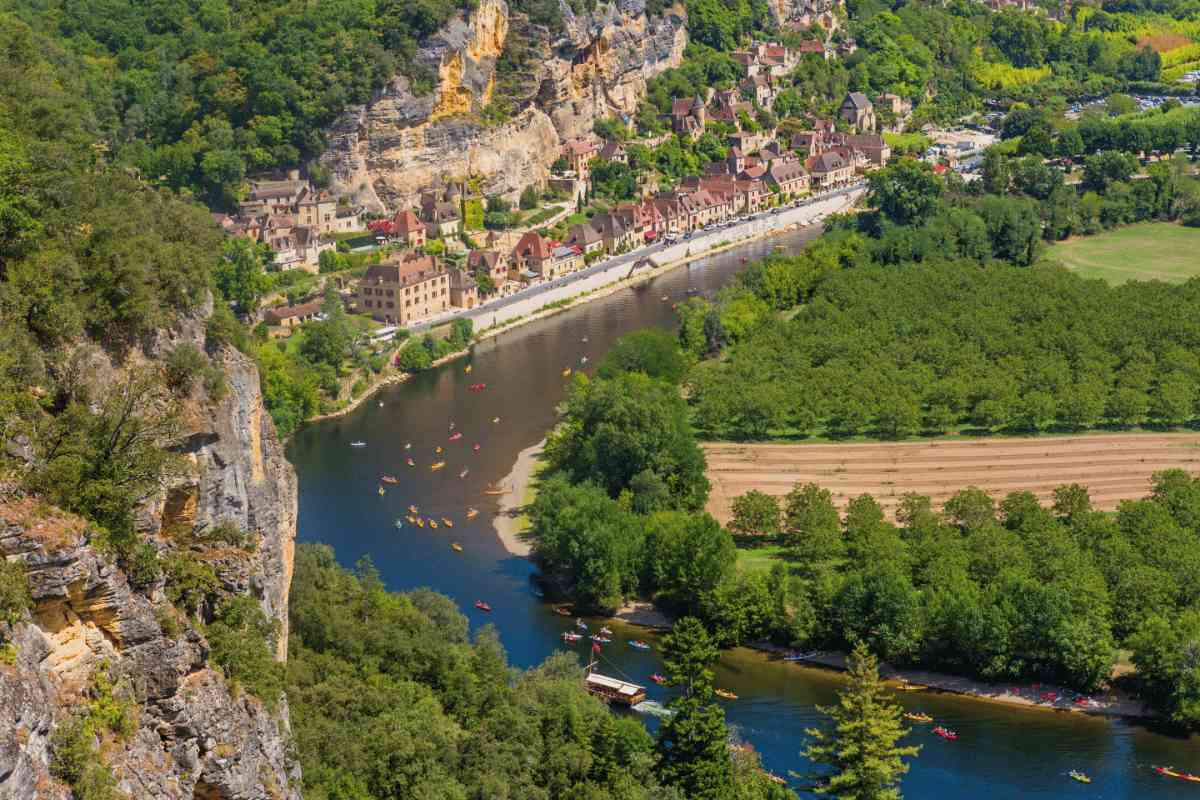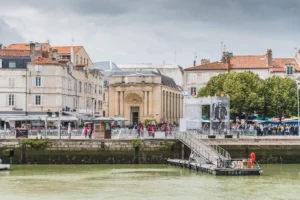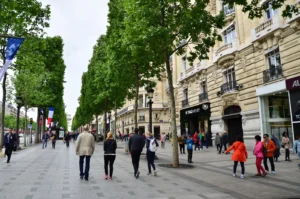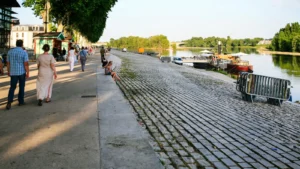Looking for what to do in Dordogne, France? You’re in the right place. This breathtaking region in southwest France is beloved for its medieval villages, hilltop castles, vineyard landscapes, and exceptional local cuisine—offering a rich, authentic escape for every type of traveler.
This region, often called France’s top non-coastal destination, draws around 3 million visitors annually. Tourism contributes about 22% of the local economy. Its appeal has only grown recently, even as the global travel industry rebounds.
Whether you’re an international explorer or a resident planning a getaway, Dordogne promises an enriching and memorable escape.
The Dordogne Region at a Glance
Picturesque view of Perigord town in France. Landscape with the river Vezere.
If you’re exploring what to do in Dordogne, France, it helps to understand the layout of this stunning region. Nestled in Nouvelle-Aquitaine, about 500 km south of Paris, Dordogne is a rural French department known for its dramatic landscapes, preserved villages, and rich cultural heritage.
Locals and travelers often refer to the area by its four “Périgords,” each offering its own flavor of adventure and charm:
- The verdant Périgord Vert in the north
- The limestone-rich Périgord Blanc around Périgueux
- The wine country of Périgord Pourpre near Bergerac, and
- The popular Périgord Noir in the southeast (home to Sarlat and the Dordogne valley).
Despite having no coastline, Dordogne is France’s most visited non-coastal area, a testament to its diverse attractions from river valleys to hilltop bastides.
History and Cultural Heritage
Streets and alleys in the picturesque medieval town of Sarlat-la-Canéda in France
One of the most rewarding things to do in Dordogne, France, is to step into its history. The region’s timeline spans prehistoric cave art to medieval battles. In the Vézère Valley, 15 prehistoric sites—including the famous Lascaux Cave—are inscribed asUNESCO World Heritage sites for their 17,000-year-old paintings.
Fast forward to the Middle Ages, and Dordogne’s rivers were strategic frontiers dotted with 1001 castles and fortresses. Meanwhile, towns like Sarlat-la-Canéda boast perfectly preserved Renaissance architecture and a maze of cobbled lanes lit by gas lamps, making you feel like you’ve stepped back in time.
Yet Dordogne is not trapped in the past—it’s a living region where tradition meets laid-back French living. Locals (many of them proud Occitan speakers) linger at café terraces and weekly marchés, exemplifying the easy rhythm of life that draws many visitors.
The area is so beloved by visitors, particularly Brits, that it’s earned playful nicknames like “Dordogneshire” or “Little England,” reflecting its large English-speaking community and expatriate population.
Don’t be surprised if you hear English accents at the village market or find pubs serving Sunday roast; Brits have been coming here for decades to enjoy the climate and countryside, with some even settling down (the small town of Eymet is about 30% British residents!). This international flair adds another layer to Dordogne’s character, all while remaining distinctly French at heart.
Why Dordogne Appeals to Every Traveler
Village of Roque-Gageac in Dordogne
Part of what makes Dordogne, France, so unforgettable is its ability to offer something for everyone. Whether you’re planning an adventurous week, a romantic escape, or a slow-paced sabbatical, the region is filled with experiences that resonate across ages, interests, and travel styles. Here’s why so many different travelers love what there is to do in Dordogne:
International Travelers
Dordogne offers an accessible yet authentic French experience. It is easy to reach by a 2.5-hour high-speed train from Paris or direct flights to Bergerac. International visitors are drawn to its breathtaking landscapes, from sunflower fields to ancient stone farmhouses, and its deep history, from prehistoric cave art to medieval castles.
Luxury Tourists
Wondering what to do in Dordogne, France, if you’re looking for elegance and indulgence? This region is perfect for a luxury countryside retreat. Stay in châteaux hotels, rent private villas, or enjoy exclusive experiences like:
- Private vineyard tours
- Sunset hot-air balloon rides
- Michelin-starred meals
- River cruises with wine pairings
It’s luxury without pretension—refined, serene, and deeply rooted in the landscape.
French-Speaking Locals (Domestic Tourists)
Dordogne offers a peaceful retreat for French families, Parisians, and locals seeking “le calme de la campagne.” Families enjoy canoeing on the Dordogne River, hiking in the Périgord Vert, and exploring the Périgord Noir’s medieval sites. The region also attracts those looking to connect with French heritage, from prehistoric art to local festivals.
Couples and Honeymooners
Romantic things to do in Dordogne include wandering through flower-filled village squares, sharing wine at a local market, or staying in a castle suite or cozy guesthouse. Whether you’re on a honeymoon, celebrating an anniversary, or planning a romantic weekend, the region’s charm makes every moment feel timeless.
Retirees and Slow Travelers
Dordogne’s leisurely pace makes it an ideal destination for retirees and slow travelers. With warm summers and mild seasons, it’s perfect for relaxing and enjoying the region’s tranquil beauty.
Visitors can explore local brocante shops, take scenic drives, or enjoy long lunches at medieval market squares. The region’s welcoming atmosphere and slower pace also attract expatriates seeking a new lifestyle.
Top Things to See and Do in Dordogne
Dordogne is overflowing with attractions – from natural wonders to historical sites – and you could easily spend weeks without running out of discoveries. Here are some must-see highlights and experiences that showcase the region’s magic:
Wander France’s Most Beautiful Villages
Dordogne is home to 10 of France’s official “Les Plus Beaux Villages.” Don’t miss La Roque-Gageac, a village between limestone cliffs and the riverbank, or Beynac-et-Cazenac, where steep lanes lead to a dramatic hilltop château.
Other highlights include Domme, with its panoramic views, and Monpazier, a well-preserved medieval town founded by an English king in the 13th century.
Step Inside Historic Castles
Image from Unlimphotos. Chateau de Castelnaud, medieval fortress at Castelnaud-la-Chapelle, Dordogne
Dordogne is dotted with stunning châteaux, each offering a glimpse into the region’s rich past. The standout is Château de Lasfonds, a 19th-century neo-Gothic château combining historic elegance with modern amenities, making it the perfect base for exploring the region’s heritage.
For other must-see castles, visit Château de Castelnaud, a medieval fortress showcasing the Hundred Years’ War history, complete with grand halls and fascinating military artifacts. Another highlight is Château de Beynac, a fortress perched above the Dordogne River, offering dramatic views and a deep connection to medieval conflicts.
Experience Prehistoric Treasures
Dordogne is renowned for its prehistoric sites, particularly in the Vézère Valley, where 15 UNESCO-listed caves can be explored. Lascaux IV, a replica of the famous Lascaux Cave, immerses visitors in the region’s 17,000-year-old paintings.
The National Prehistory Museum in Les Eyzies offers further insight, while sites like Font-de-Gaume and Rouffignac allow visitors to see original cave art.
Savor the Flavors of Périgord
Outdoor dining at Chateau de Lasfonds
Food is central to Dordogne’s identity. This is one of France’s great gastronomic regions, famed for products like foie gras, black truffles, walnuts, and rich duck confit. Visiting a local market is a must-do: towns like Sarlat, Bergerac, and Périgueux host weekly markets overflowing with seasonal produce, cheeses, charcuterie, fresh breads, and sweet treats.
In Sarlat’s Place de la Liberté, the Saturday market feels like a festival of flavors, where you can snack on tourtière apple pastries or sample foie gras on toast with a glass of Monbazillac wine in hand.
For an extra exceptional foodie experience, time your visit for one of the night markets in summer. These communal feasts typically feature stalls cooking farm-to-table dishes, which you enjoy at picnic tables under the stars, often with live music.
And if fine dining is your style, indulge at a Michelin-starred restaurant such as Le Vieux Logis in Trémolat or Les Fresques near Monestier. These establishments marry Périgord ingredients with world-class culinary technique, resulting in unforgettable meals.
Wine lovers will also delight in Dordogne’s offerings: the Bergerac wine region produces excellent reds and sweet whites (like Monbazillac), and many vineyards welcome visitors for tours and tastings. Don’t leave without trying walnut cake with a drizzle of walnut liqueur – an authentic taste of Dordogne’s terroir.
Enjoy Outdoor Adventures
Image from Unlimphotos. Castle and gardens of Marqueyssac
Nature lovers have plenty of ways to explore Dordogne’s great outdoors. The winding Dordogne River (and its tributary, the Vézère) are perfect for canoeing and kayaking – a leisurely paddle will take you past cliffs, forests, and riverside châteaux, with chances to stop at pebble beaches for a picnic or swim.
Suppose you prefer someone else to do the steering, hop on a traditional gabare (flat-bottomed wooden boat) cruise, especially at La Roque-Gageac. In that case, you’ll learn about the river’s history as a trade route while soaking up the scenery. The region also has hundreds of kilometers of hiking and cycling trails.
In the Périgord-Limousin Regional Park (north Dordogne), trails wind through chestnut woods and past hidden hamlets – great for birdwatching and enjoying wildflowers. Down south, you can cycle the “Voie Verte” (greenway) along a former railway from Sarlat to Souillac.
For a unique biking experience, try the vélo-rail near Rouffignac, pedaling a rail-cart through the countryside and tunnels. Hot air ballooning is another popular activity, offering a breathtaking bird’s-eye view of the valley’s patchwork of farms and castles in the early morning light.
And after all that activity, why not unwind in nature?
Dordogne has several beautiful gardens open to the public, like the Marqueyssac Gardens with its famous topiary overlooking the river, or Eyrignac Manor Gardens with its roses and ornate hedges. Whether you’re seeking adrenaline or tranquility, the region’s rivers, cliffs, and forests provide an ideal playground.
When to Visit Dordogne
Image from Unlimphotos. A walk in a boat on the Dordogne on board traditional boats called barges
Thanks to its moderate climate, Dordogne is a year-round destination, but each season offers a different experience:
Summer (June–August)
Summer is the peak season in Dordogne, with long sunny days and a lively atmosphere. It’s the best time for outdoor activities like river cruises and festivals. However, the region can be busy, so visiting popular attractions early in the day is wise. Expect higher accommodation prices, but the energy and vibrant summer events make it worthwhile.
Spring (March–May)
Spring in Dordogne offers mild weather and a burst of natural beauty. Wildflowers blanket the landscape, and fruit trees are in bloom. This season is quieter than summer, making it perfect for hiking and cycling before the crowds arrive.
While rain is occasional, the peaceful ambiance and lower prices make spring a favorite for those seeking a calm retreat.
Autumn (September–November)
Autumn is another excellent time to visit. The weather is still warm in early fall, and the grape harvest season brings a special charm to the vineyards.
By late October, the crowds thin out, making it ideal for outdoor activities and castle tours. While the weather cools, the vibrant fall foliage and harvest festivals add to the region’s allure.
Winter (December–February)
Winter in Dordogne is peaceful and intimate. Though some attractions may have limited hours, it’s the ideal time to experience the region like a local. Enjoy cozy fireplaces, truffle hunting, and Christmas markets in towns like Sarlat.
The cold weather offers a slower pace, and accommodation prices are at their lowest, making it perfect for those seeking a quiet, authentic escape.
In summary, there’s no bad time to visit Dordogne – it depends on your preferences. Summer brings maximum activities and buzz, spring and fall balance good weather with fewer crowds, and winter offers an intimate escape and gastronomic delights (truffles galore!). Whenever you go, the region’s beauty and hospitality remain constants.
When exploring Dordogne, many travelers also dream of a château experience. While Château de Lasfonds offers an unforgettable stay in the heart of the region, you can also explore our broader guide on Where to Stay in France to compare other exceptional castle stays across Nouvelle-Aquitaine and beyond.
Experience Château de Lasfonds – Your Luxury Retreat in Dordogne
Chateau de Lasfonds
After exploring the delights of the Dordogne, imagine ending your days in a beautiful French château where you have the entire estate. If that sounds like a dream, allow us to introduce Château de Lasfonds, an exceptional rental property that lets you “rent a castle” in the heart of Dordogne.
Located on the edge of the Périgord Vert (less than an hour from Périgueux) and perched atop a gentle hill, Château de Lasfonds offers modern comfort amid historic grandeur.
Open year-round, this 19th-century neo-Gothic château has been meticulously restored to its former splendor. It retains romantic features like turrets, a monumental staircase, Renaissance-style stained glass windows, and even a period-style kitchen while integrating high-end amenities.
Staying here is like stepping into a French fairytale—with central heating and Wi-Fi! It is truly the best of both worlds.
What Makes Lasfonds Special?
Interior of Chateau de Lasfonds.
For one, the property is entirely private – a 6.5-hectare (16-acre) estate of woods and meadows surrounds the castle, with no immediate neighbors. You can relax by the gardens, stroll under century-old trees, or enjoy an evening aperitif on the terrace, gazing at uninterrupted countryside views.
The estate is a short drive from regional airports and roughly 2.5 hours by TGV train from Paris (plus a scenic drive), so your group can convene here with minimal fuss.
Ideal Accommodation for Small Groups
The château features 607 m² of living space with four air-conditioned suites, comfortably housing 8-9 guests. Four guest cottages, including the Lavender Cottage and Loft Gîte, provide additional accommodations for 10+ guests. It’s ideal for family reunions, weddings, or group vacations.
Comfortable and Charming Spaces
The château combines historic charm with modern amenities. The ground floor includes a cozy lounge, fireplace, fully equipped kitchen, and intimate dining room. Upstairs, a library and entertainment room offer additional spaces for relaxation. The décor blends antiques with contemporary comforts, creating a warm, inviting atmosphere.
Outdoor Enjoyment
The estate boasts manicured gardens, open lawns, and wooded paths. Outdoor dining areas, BBQ spots, and garden patios provide a perfect setting for meals or relaxation in nature.
Bespoke Services
The château offers concierge-like services, from private chefs and cooking classes to winery tours and on-site massages. A hot-air balloon ride can even be arranged for special occasions, ensuring a personalized experience.
The Perfect Getaway
Château de Lasfonds is ideal for international travelers, couples, families, and retirees looking for a unique, luxurious retreat in the heart of Dordogne: experience history, comfort, and privacy in this unforgettable château setting.
Ready to live the château life? Château de Lasfonds invites you to create your story within its historic walls. Wake up to misty valley views and the smell of fresh croissants delivered to your door.
Spend days exploring Dordogne’s wonders, knowing a plush armchair by the fire and a comfortable bed in a castle await your return. It’s the ultimate way to savor Dordogne – in style, comfort, and exclusivity.
Don’t just visit Dordogne… experience it by making this timeless château your home away from home. Your Dordogne dream begins here!
FAQs about Discover What to Do in Dordogne, France
Dordogne is known for its medieval castles, charming villages, rolling vineyards, and exceptional cuisine. The region is a paradise for history lovers and food enthusiasts, offering stunning landscapes, ancient caves, and vibrant local culture.
Key attractions include the Lascaux Caves, Château de Beynac, and the picturesque town of Sarlat-la-Canéda. The Dordogne River offers boat trips, and the medieval villages of Domme and La Roque-Gageac are not to be missed.
Yes, Dordogne is perfect for outdoor enthusiasts. Hiking, cycling, kayaking, and hot-air ballooning are popular activities. The region’s stunning natural beauty provides endless opportunities for adventure, from the hills of the Périgord Vert to the Dordogne River.
The best times to visit are spring (April to June) and fall (September to October). The weather is pleasant during these seasons, and you can experience the region’s beauty without the summer crowds.
Dordogne is famous for its rich culinary tradition, especially dishes like foie gras, truffles, and duck confit. The region’s markets offer fresh produce, local cheeses, and wines, making it a paradise for food lovers.
You can reach Dordogne by flying into the nearest airports in Bergerac or Bordeaux. Alternatively, you can take a train to Périgueux or Sarlat-la-Canéda. Driving is also a great option, as the region is well-connected by road.
Yes, Dordogne is an excellent destination for families. The region offers kid-friendly activities like visiting castles, exploring caves, and enjoying boat trips on the Dordogne River. Many towns have playgrounds, and there are numerous family accommodations.
The most charming villages include Domme, La Roque-Gageac, and Beynac-et-Cazenac. These medieval towns feature cobbled streets, ancient buildings, and stunning views, offering a step back in time.
Yes, cycling is a popular activity in Dordogne. The region offers scenic bike trails, including routes along the Dordogne River, through vineyards, and past historical landmarks, making it a cyclist’s paradise.
Dordogne is rich in history, with many sites dating back to prehistoric times. Don’t miss the Lascaux Caves, Château de Lasfonds, and the many medieval castles scattered across the region.




